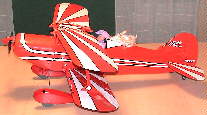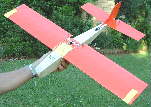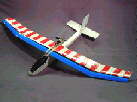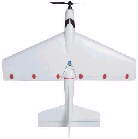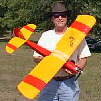 |
Flying High With Electric Power!
The Ampeer ON-LINE!
Fly the Future - Fly Electric! |
Site Table of Contents
| President: | Vice-President: | Secretary/Treasurer: |
| Ken Myers | Richard Utkan | Debbie McNeely |
| 1911 Bradshaw Ct. | 240 Cabinet | 4733 Crows Nest Ct. |
| Walled Lake, MI 48390 | Milford, MI 48381 | Brighton, MI 48116 |
| (248) 669-8124 | (248) 685-1705 | 810.220.2297 |
 | ||
| Board of Directors: | Board of Directors: | Ampeer Editor |
| Jim McNeely | Jeff Hauser | Ken Myers |
| 4733 Crows Nest Ct. | 18200 Rosetta | 1911 Bradshaw Ct. |
| Brighton, MI 48116 | Eastpointe, MI 48021 | Walled Lake, MI 48390 |
| (810) 220-2297 | (810) 772-2499 | (248) 669-8124 |
| Mailed Ampeer subscriptions are $10 a year US & Canada and $17 a year world wide. FREE on-line! | ||
| The Next Meeting: Date: Thursday, Jan. 2 Place: Ken's house: Time: 7:30 p.m. | ||
|
From: George Zhopasruchkoy zhopasruchkoy@yahoo.com Hi Ken, I would like to thank you for your help, suggestions and inspiration in building this beauty. It flies great with an Astro Flight 802G with 11x7 and 9 CP-1700SCR cells. The weight is about 42 oz. - little bit overweight, (and I still don't understand why) but flies great. Thanks again,
An Old Plan Modernized
Hi Ken, I have attached a couple of photos of my latest effort. The design is called
"Premier" and was a free plan in Aircraft Modeller May 1991. The original was powered by a .049 Cox and was
built accordingly [Heavy]. The original wing used a Clark "Y" section. I changed this to SD3021 and placed a block
under the trailing edge at the approximate position I thought would be correct. The fuselage was constructed from 1/16"
[1.6mm] balsa with a 1/32" [.8 mm] vertical balsa doubler and a nose block added to accommodate the speed 400.
Stay Well,
From: James Maughan jamesmaughan@yahoo.com Ken, Hello...I recently found a battery supplier on the net that has good products and
the prices are very good. In case you are interested: cheapbatterypacks.com
Molybdenum Disulfide Question
Ken, I read the article in the August 2002 Ampeer concerning the lube benefits of molybdenum disulfide for electric motors. I've searched the Internet and found (Rose Mill), but they only sell in large quantities. I have tried to contact Gary Baker who gave the info to Ampeer by email several times but always get my mail returned. Perhaps some of the Ampeer readers can suggest a source. I would appreciate it. Regards,
FYI News Larry Sribnick, owner of SR Batteries, puts together an email news update called FYI. It lets you know before anyone else what the ďhotĒ news is at SR. You can subscribe by visiting: www.srbatteries.com/rc.htm It is NOT my intention to republish what Larry sends out here, but... Here is some info from Larryís latest issues of FYI. Box 287, Bellport, New York 11713 Email: techsupport@srbatteries.com Web Site: http://www.srbatteries.com Phone: 631-286-0079 (C) Copyright 2002, all rights reserved by SR Batteries, Inc.
The AcroPro kit and the AcroPro Wing Conversion for the Cutie are both being shipped! AcroPro Kit and Wing Conversion... We started shipping the new AcroPro kits last week. The AcroPro section of our web site is up and available. www.srbatteries.com/acropro.htm Paul Matt Drawings and Golden Age of Aviation Books...
November 6, 2002 This is an exclusive for FYI readers! The new AcroPro kit won't be announced to
the public for several weeks. There's even a special "deal" for FYI readers!
Well, it's finally time to tell you all about our new AcroPro kit.
As for the AcroPro's power system, here's what you get...
Getting Started in Electrically Powered Radio Control Flying
Where to begin? There are so many things to say about getting started. They can
include what you might need, who you can learn from, where you can purchase items, even why you might have a desire to learn
to fly electrically powered R/C models.
Donít get into this hobby to "try" it to see if you like it. Donít try to get someone else, like your kids, into this hobby. The only valid reason to get into this hobby is because you find "flight" fascinating. If you have no "emotional" connection with things that fly, donít even think about getting into this hobby. If you do not have a passion for aviation, past, present and future, do not consider this hobby. If you just want to control something remotely, because you have a desire to have something that you can control in your life, this is NOT the hobby for you. Buy an R/C car at Radio Shack. If you do have the true desire, you must have the ability to use part of your income for things other than paying the monthly bills and putting food on your table. If you donít have enough money to do it right, start saving, or donít do it at all. Donít give in to "impulse buying" just to satisfy an immediate desire or curiosity. Make sure you are using your disposable income to its fullest advantage. Donít feed the sharks! Avoid, like the plague, complete, electrically powered R/C beginner packages in this price range. They are garbage. They are chum. They do not allow you to enter this hobby and learn how to fly electrically powered R/C planes. You are feeding the sharks, and the only thing youíll have to show for your money is an expensive lesson. You cannot purchase a decent radio system, plane, charger and power system for learning to fly electrically powered R/C planes with only this amount of money. If anyone says you can, run as fast as you can away from them. They want your money, and thatís all. No matter what the video that may have come with the package says or shows you, you will not learn to fly with that original package. With enough patients, parts, pure luck and money, you can teach yourself to fly an electrically powered R/C plane. It will not be that original $100-$200 package. You will have replaced parts of the airframe, possibly tried a different power system or even purchased a charger that will actually charge your batteries correctly. Teaching yourself to fly will substantially increase your original investment! Flying electrically powered R/C planes is not a solitary type activity. It is a social activity. Yes, there are times folks fly alone, but over the long run, it is a social activity. The passion for aviation ties those involved with this hobby together and draws them together in both physical and virtual places. There are many hobbies available to you that are solitary activities. You should really consider those hobbies if you are the "I can do anything myself" kind of person. The bottom line is, seek qualified help, if at all possible! Overcome your shyness. Donít be afraid to ask questions and ask for help. Youíll save a lot of money, time and frustration, and youíll make some great new friends that just might be around for the rest of your life. Read as much as you can about this hobby before getting into it. There is one good book on the subject. If you get lucky, your local library might even have it. Clean and Quiet by Bob Aberle is available from Carstens Publications phone: 973-383-4064 or www.carstens-publications.com/hangar.html Unfortunately, this book is a few years old now, but it is still the best overview book available. Bob also has another great book out now, Getting Started in Backyard Flying. While this is a growing and exciting aspect of the hobby, it has NOTHING to do with LEARNING to fly electrically powered R/C models. Slow flyers, backyard flyers and a lot of park flyers do not make good trainers. The do fly easily and for a long enough period of time, but they cannot fly frequently enough, because of the weather, to be good trainers. Magazines are the poorest source of information for beginners. Every article published says how good a model is. You may see some slight, minor criticism, but you will never see an article that totally warns you against an unacceptable product. A magazineís revenue is totally dependent on advertising. Advertisers, or the fear of advertisers removing their ads, totally control what is published in the reviews. While Iíve been criticized for saying this before, I will say it once again. If, through your research into ads, youíve found a beginnerís model that has been on the market for some time, and you do not find any reference or review in a national and international modelling magazine, stay away from it. The review was either never written because the reviewer couldnít find enough positive to say about it, the magazine turned down the review because it was too negative or returned if for revision. Iíve been criticized for saying this because maybe the magazine hasnít had time to get the product into an evaluatorís hands, maybe the evaluator hasnít had time to do the article or maybe the magazine has the review, but they havenít had the room to run it yet. That all could be very true, but more than likely, not. Why? If there were a hot, new, revolutionary product that could make a beginner into an R/C pilot quickly and inexpensively, the magazines would be all over it. They would have someone on it "right away." Theyíd want to be the ones to scoop this great new event in the R/C hobby. If it has happened so far, I missed that issue! With the psychology and merchandising out of the way, it is time to define the beginnerís plane. The plane should fly well. It should be quite stable when flying with no inputs from the pilot, much like a free flight model. It should, on itís own in free flight, want to return to a normal flight attitude when bumped by turbulence. It should fly for 7-10 minutes. That is the length of a good training flight for a beginner. It should be able to fly well and easily with the wind in the 5 to 10 mph range without requiring an excessive amount of control inputs from the pilot, or becoming unstable because it is flying too close to an aerodynamically stalled condition. It should be large enough to be able to tell its attitude and direction at a distance, which is even farther away than you might expect. It should safely fly at a relatively slow speed to allow for the slower reflexes and unlearned skills of the beginning pilot. If the only help available is at a club that typically flies only glow models, then it should fly similarly to a glow trainer, since that is what the instructor will be familiar with. The power system should be able to provide the power required to fly the plane for the 7-10 minute training flights. The motor should be matched to the airframe for the task of training. The batteries should be NiCads. NiCads recharge at the field from 2 to 4 times faster than NiMH cells. You should have 3 packs for the trainer. One will be used to fly the plane, one will be cooling and one will be charging. Good training requires the maximum amount of flying in the minimum amount of time. Good training days are hard to come by and should be used to their fullest! It is very hard to match your time, your instructorís time and the weather. It is best to use a major brand. These include, in no specific order; Hitec, Futaba, JR and Airtronics. Radio systems by these manufacturers have discrete components that can be used over and over again. They can be combined with other easily obtainable components for new tasks. The onboard radio components should match what is needed for safe control of the aircraft. The trainer should have a speed control, not an on/off switch. The speed control should be reliable, easy to set up and safe to use. The charger should be capable of charging a minimum of 6 to 10 cell packs at a least 5 amps. It should be able to charge more than 7 cells. It should be simple to use and have a peak detector circuit. It should be able to be hooked up to the source battery directly. You do not need a charger that can plug into household current. It should NOT plug into what used to be called a cigarette lighter socket in a vehicle. The sources listed may or may not be the only sources available. The prices listed represent those found while writing this article in December of 2002. The Push-E Cat from Garrison Aerodrome is the 1st choice. To learn more about it visit: www.rc-aero.com/kits/pushe It is durable, being made of EPP foam, but durable is NOT that important in a trainer, "flyability" is. It flies well enough to be a trainer. It handles wind well. It has a pusher motor, which helps protect the motor on a less than perfect landing. The Push-E Cat site lists the various suppliers for this plane. New Creations R/C (www.newcreations-rc.com) lists the sale price as $69.95. Plane Stats:
Radio choices:
Use the Push-E Cat setup and add a computer R/C flight simulator like Cockpit Master (www.cockpitmaster.com). You want the standard version, not the Backyard version. The downloadable version is $49.50 plus the interface cable that will work with your transmitter $27.50. Find a HUGE open area where there are absolutely no other people or objects. After many, many hours on the R/C flight simulator, go to that HUGE open area with winds below 10 mph and give it a try. Be ready to crash many times, and possibly loose your investment with a flyaway because youíve become disoriented. Teaching yourself to fly will substantially increase your original investment! This is a second choice set-up if donít want to build, and seems to fall into the category I do not recommend. It is available from Tower Hobbies #LXCTE7 $169.99. I donít like the Focus 3 AM radio, but it will work for you. I really donít like the charger that comes with it, but it will work for you. Youíll need dry cells for the transmitter. Youíll need two more battery packs, from Tower Hobbies #LXVB79 at $26.99 each, $53.98. You should immediately replace the Tamiya type connectors with Anderson Power Poles, Tower Hobbies has them listed as DuraTrax Powerpole Connector (2 Pair) #LXD175 $3.49. Two packages are needed, $6.98. Bottom line, about $240 by the time its ready to fly. In reality, you will want to immediately replace the charger, so using the Hitec CG-335 adds another $89.99, bringing the cost to about $330. Plane stats:
The first choice is the SR Batteries Cutie. Yes, you can build this plane if youíve never built anything before. It is the perfect kit with the perfect instructions for the beginner. You could search around for better prices on a few of the items, but Iíd recommend that you get a lot of what is listed on the SR Batteries Cutie page, plus 2 extra battery packs, not just one. Iím sure Larry would be willing to cut you the same deal on the 2nd extra battery pack. In addition to the items that Larry lists, youíll need single-edged razor blades, CA glue and a covering iron. Hereís what youíll need from Larry: The Cutie kit: $119.95 Power System: $169.95 2 Optional additional battery packs: $55.95ea = $111.90 5/64" Ball Driver: $3.95 Total for SR Batteries: $405.75 Other: Charger: Acceptable: Hitec CG-335 Multi-Peak Charger Tower Hobbies #LXN747 $89.99 Recommended: Astro Flight 110Deluxe Tower Hobbies #LXDJN0 $117.99 Radio System: Acceptable: Hitec Focus 3 3-Channel FM/555 Rx/2 HS-81 Servos Tower Hobbies #LXWB67 $104.99 Recommended: Hitec Laser 4-Channel FM Glider/2 HS-81 Servos Tower Hobbies #LXANT7 $139.99 Other Acceptable total: $195 Other Recommended total: $258 Misc.: 2 rolls of TowerKote: $5.99 ea = $11.98 Top Flite Sealing Iron #LXHZ17 $16.99 Great Planes Pro CA Glue 1 oz. Thin #LXK282 $3.99 Great Planes Pro CA+ Glue 1/2 oz. Medium #LXK285 $2.99 Single-edged razor blades (local) Misc: total: $36 Bottom Line: Acceptable: $637 Recommended: $700 Plane Stats: Span: 46" Wing Area: 360 Sq. In. Weight: 27 oz. You will want an instructor. You now have an emotional investment in this aircraft as well as large monetary investment. Any glow instructor can handle this plane, and it will take off from short, mowed grass. The second choice would be the Spirit of Yesteryear Amptique. The kit is good, but not as good as the Cutie with its laser-cut parts and fantastic instruction sheet, but it is still very "buildable" by a beginner. Amptique kit: New Creations R/C #SY0704 ... $55.95 Power System: Master Airscrew - Motor/gear-drive/prop: Tower Hobbies Master Airscrew 2.5:1 Electric Flight Pack #LXZ905 $31.99 3 ea Sanyo CP-1700SCR 7-cell packs Diversity Model Aircraft $48 each = $144 Anderson Power Poles, Tower Hobbies has them listed as DuraTrax Powerpole Connector (2 Pair) #LXD175 $3.49 (and wire for motor- not included in pricing) Charger: Acceptable: Hitec CG-335 Multi-Peak Charger Tower Hobbies #LXN747 $89.99 Recommended: Astro Flight 110Deluxe Tower Hobbies #LXDJN0 $117.99 Radio System: Acceptable: Hitec Focus 3 3-Channel FM/555 Rx/2 HS-81 Servos Tower Hobbies #LXWB67 $104.99 Recommended: Hitec Laser 4-Channel FM Glider/2 HS-81 Servos Tower Hobbies #LXANT7 $139.99 Other Acceptable total: $195 Other Recommended total: $258 Misc.: 2 rolls of TowerKote: $5.99 ea = $11.98 Top Flite Sealing Iron #LXHZ17 $16.99 Great Planes Pro CA Glue 1 oz. Thin #LXK282 $3.99 Great Planes Pro CA+ Glue 1/2 oz. Medium #LXK285 $2.99 Single-edged razor blades (local) Misc: total: $36 Bottom Line: Acceptable: $467 Recommended: $530 Plane Stats: Wingspan: 61" Wing area: 518 sq. in.
Sources: Web sites & Phone numbers Carstens Publications:
Garrison Aerodrome: www.rc-aero.com/kits/pushe Phone: (330) 220-1968 New Creations R/C www.newcreations-rc.com Phone: (936) 856-4630 Tower Hobbies www.towerhobbies.com Phone: 800-637-6050 Northeast Sailplane: www.nesail.com Phone: (802) 655-7700 Diversity Model Aircraft: www.flydma.com Phone: (858) 693-8188 B&T Racing Products: www.rc-aero.com/biz/bandt Phone: 919-471-2060 Cockpit Master: www.cockpitmaster.com Phone: 615-373-1444 this will get you Hobby Lobby, where you can order the CD-Rom version SR Batteries: www.srbatteries.com Phone: 631-286-0079 There are many other great sources for these products. Iíve listed ones that Iíve dealt with personally, or that I know have a good reputation. Iíve flown, instructed, or have very good second-hand knowledge on all four of these planes, and I cannot recommend them highly enough.
If you think Iíve been on a rant, I apologize. Iím just tired or beginners being taken advantage of. For further reading on this topic, I recommend the "Radio Control Electrics" column by Bob Kopski, page 97, Model Aviation, January 2003. Look at the bottom line pricing again. In your mind, remove about $100, as the bottom line pricing includes your initial purchase of a decent charger. Also, if you build the plane yourself, several of the "building" items will be used on future projects. Keep this in mind, when comparing the build-it-yourself kits. I apologize for not including all of you! I wanted to keep this piece as simple as possible for the beginner, who really canít buy it all in one place. Rest assure yourself that if Iíve bought things from you, flown with you or know your good reputation, you are high on my recommendation list when Iím asked specific questions and "who can/should I get this from?" A Ampeer Correction and The Saga of Astro Flight 803V
In my article "Powering the JM GlasCraft Cheap Thrills"
in the December 2002 Ampeer, I mistyped the weight of the FMA Extreme 5. It should have been
0.4 oz., not 0.04 oz. Thanks Bernard! I used the correct weight when doing the figuring.
The December EFO Meeting The meeting started at Kenís house about 7:00 with Manwich pizza, potato chips,
pop (provided by Howard Shorr - thank you) and cookies (provided by Dave Stacer - thank you). After a little eating and a lot of
chatting, the folks left for the Oakland Yard at about 8:30, where many of the EFO members flew.
To Reach Ken Myers, you can land mail to the address at the top of the page. My E-mail
address is:
KMyersEFO@aol.com
|
